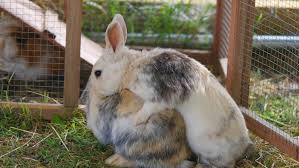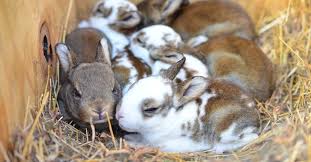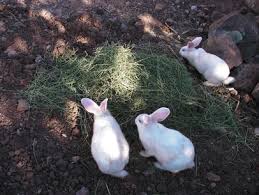Reproduction is the process of giving birth and is a complex procedure controlled by hormones produced in endocrine glands, including the ovaries.
These hormones, which are produced in small amounts, are transported to the target organs through the blood circulation system. Different hormones act on different parts of the reproductive system at various times to ensure successful reproduction.
1. Selection for Breeding Stock
Breeding stock should be selected from does that are good mothers and have a suitable body size and shape. It is important to consider the live weight of the rabbits, choosing the heaviest, while also accounting for any age differences if selecting from more than one litter.
Preference should be given to rabbits from the largest litters, provided there are enough litters to choose from. Rabbits should be free from any signs of ill health, and males should be checked to confirm that they have two testicles in their scrotum.
Read Also: Best Snail Rearing Stocking Density for Best Results
2. Mating in Rabbits

In forage-based systems, does are typically ready for mating at about 8–10 months. At this age, their growth slows, and they can direct more of the available food towards reproduction.
The weight at mating varies according to breed, and effort should be made to determine the optimum weight for mating for each breed. Bucks, like does, should be in good condition and can usually start mating from 6 to 8 months. The ratio of does to bucks should not exceed 10:1.
For safety, it may be advisable to have two bucks for more than six does, and three bucks for more than twelve. Experience shows that early morning or evening mating is best, avoiding the hottest periods of the day.
For mating, the doe should be taken to the buck’s hutch. If the doe is brought to the buck, she may attack him, causing injury. When the doe is ready to mate, she will stand still within a few seconds, stretch out, and slightly raise her hindquarters, allowing the buck to mount.
Successful mating is signified by the buck thrusting forward and literally falling off the doe. If the buck slides backward and does not fall, mating has not taken place. After mating, the doe should be removed from the buck’s hutch but may be returned for a second mating after an hour or so. This is recommended for new keepers.
Read Also: Seasonal and Daily Management Practices for Snail
3. Care of Doe During Pregnancy

Pregnant doe will often accept the buck during pregnancy, so refusal to mate cannot confirm pregnancy. The first real confirmation of pregnancy can be made about 14 days after mating.
At this stage, the doe should be relaxed and sitting naturally. If fingers are gently run along the abdomen, small bead-like lumps can be felt if the doe is pregnant; these are developing fetuses. Inexperienced keepers should practice detecting pregnancy in does that are 20 days pregnant, at which stage the fetuses are easily identified. By about 28 days, the mammary glands will have developed significantly, confirming pregnancy.
At around 29 days, the doe will begin removing fur from her abdomen to make a nest. Pregnancy, or gestation, is the time from fertilization to kindling, which typically takes 31 to 32 days. On average, the pregnancy period lasts about 30 days in common commercial breeds. During this time, the doe should be well fed and protected from stress, such as dogs or loud noises.
4. Gestation Period in Rabbits
The gestation period is the time from fertilization to kindling and lasts about 31 to 32 days. The average pregnancy period for commercial breeds is 30 days. About four to five days before kindling, a nesting box should be provided with wood shavings or fine straw on the floor.
The doe will start removing hair from her abdomen and sides, placing it in the box to create a warm cushion for the young ones. Rabbit young are born naked and blind. The mother uses the fur to cover them and keep them warm.
5. Kindling in Rabbits
The doe typically kindles or gives birth at night. Once kindling is completed, the doe will pluck more fur from her abdomen to cover the young rabbits. It is best to leave her undisturbed for two to three days after kindling unless obvious problems arise. It is also a good practice to have some cotton wool ready to cover the litter if the doe has not done so properly.
6. Weaning of Young Rabbits
Weaning is the separation of the doe and her young, usually done around six to eight weeks after kindling. The best method of weaning is to remove the doe from the litter, as removing the young can cause unnecessary stress.
After weaning, it is important to feed the young some concentrates, if available, to support their growth. Small amounts of concentrate will greatly impact their growth rate.
As the rabbits grow, they can gradually be taken off concentrates, but their growth rate may slow down. After weaning, the litter will require more hutch space, and the doe should be allowed time to recover her body condition before remating.
Weekly weighing is the best method to ensure the doe is regaining her body reserves. Does can continue breeding until they are three to four years old.
In conclusion reproduction is a complex process controlled by hormones, and the breeding stock should be carefully selected from does with good maternal traits and appropriate body size. Proper mating, pregnancy care, and weaning practices ensure the healthy development of offspring.
Do you have any questions, suggestions, or contributions? If so, please feel free to use the comment box below to share your thoughts. We also encourage you to kindly share this information with others who might benefit from it. Since we can’t reach everyone at once, we truly appreciate your help in spreading the word. Thank you so much for your support and for sharing!

